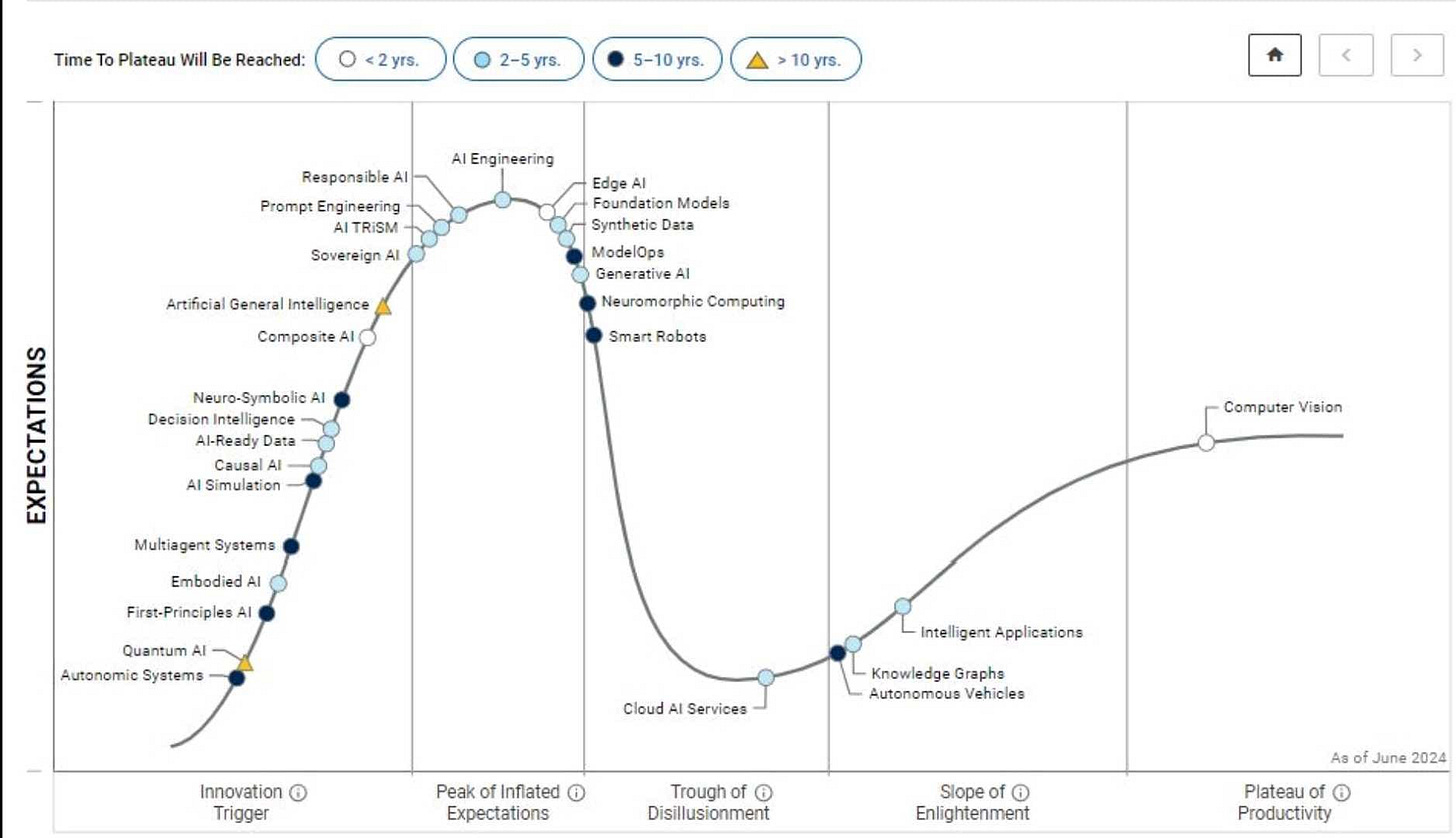An inbox designed for reading newsletters: Meco is a distraction-free space for reading newsletters outside the inbox. Become a more productive reader and focus on what matters to you - easy to try with a free version. Try today
Friends,
Over the last few weeks, the Gartner's hype cycle has come up in more than one conversation. The Gartner Hype Cycle is a graphical representation of the stages a technology goes through from the initial development to its commercial availability and adoption, as well as its eventual decline and obsolescence. What comes up is where we (me and those more brainier) see Generative AI in that hype cycle. Well, Gartner believes as of June 2024 that we have already seen peak hype for Generative AI, but there are other related hype expectations on the way. See for yourself:
I have a love/hate relationship with the hype cycle. On the one hand, It’s good to monitor what’s happening - but, on the flip side, it’s over-simplistic - the focus on the hype is not necessarily a good thing for all businesses. For example, the prediction is that GenAI will plateau in 2-5 - but it’s actually changing the landscape of many industries. The model works well and doesn’t work well - it’s misused.
If you go back to previous iterations, you’ll see that they missed some of the big finds, and the model doesn’t really look at how big or impactful the tech is. The Hype Cycle shows us how fast tech is changing and I’m sure we will see other elements in their own curve as we see above. Gartner predicts 80% of companies will use GenAI by 2026. That's huge growth from just 5% in 2023. So, it helps spot trends and make smart choices about decisions to make, but worth not spending too much time on it. However, I’ll still look at it annually with my FOMO hat on.
This month, I have been attempting to analyse and review university choices for my daughter. It has involved traipsing across the country to find the best feel for where she wants to spend her formative years as an adult - or “learning how to adult”. You can’t decide this without being in person. But, I have needed data to support me in comparing these universities with each other and supporting her with her decisions. Unfortunately, it’s not an easy task and while there are products available (e.g. Unifrog etc.) there aren’t the granular data points that you really want to check between universities at a course level, e.g. contact hours, average salaries of graduates, number of first-class honours given etc. This should be a perfect task for AI to be my helper.
So I asked ChatGPT.
The data that I received back in asking these questions seemed not quite right. My spidey senses thought to ask to dig deeper and I asked for sources. One of the answers I got was this: “These percentages are illustrative and should be verified with actual data for accuracy” - ie ChatGPT made it up. That’s commonly known as creating synthetic data.
How do we know when to trust the data? This reminded me that these LLMs are not primary sources and are only as good as the data that they are trained on. It’s why you need to confine the analysis to sources you trust. (I've subsequently uploaded more data that I have collated and the analysis is sound - but it was an eye-opener.) This doesn't mean generative AI can’t fully be trusted. It means that we are still figuring it out. It certainly doesn’t mean that it lacks value. What you do need to do is rely on professionals who understand the nuance to support bigger decisions. Relying on something so unpredictable for major, life-changing decisions is too risky.
How could GenAI be such a failure at a simple collation task and lie about the solution - but also undertake complex multi-source analysis on strategies employed by other companies, for example?
This uncertainty phase is fragile. Over time the layers and product that we build on top of LLMs will know the cracks and intricacies of what works and doesn’t work and will fill the gap as we understand the limitations.
This is why we need to think about another model when we think of the Hype curve - Crossing the Chasm. "Crossing the Chasm" refers to the critical phase in the technology adoption lifecycle where a product transitions from early adopters to the early majority. This phase is challenging because it requires appealing to a broader audience beyond initial enthusiasts and it’s one that I spend my working life in. Successfully crossing the chasm can lead to mainstream market adoption and significant growth in companies.
With GenAI, we are currently veering up the early adopter curve. Artificial intelligence, has improved significantly over the decades but hasn't yet reached the majority stage. The model shows adoption starting with innovators, followed by early adopters, early majority, late majority, and finally, laggards. Technology like the Internet are in the late majority or laggard phase and similarly smartphones. We have the majority of the world using them.
To reach the early majority - or to cross the chasm, you need a beachhead product. Geoffrey Moore, in the book, suggests that a beachhead product is a small, well-defined segment of the early majority that a company should focus on in the first part of the product adoption lifecycle. This strategy is a stepping stone towards the mainstream market, and it can help companies gain a competitive advantage before entering larger markets. ChatGPT is the current beachhead for us early adopters, just like the iPhone was for smartphones, as Tesla was for EVs as Microsoft Windows was for operating Systems, as Netflix was for streaming, as Fitbit was for wearables, as Spotify was for music streaming, as Zoom was for vidcons, as Uber was for ride hailing.
I cite all these examples, so you can think back to when we were early stages with these segment-defining products and where we are with GenerativeAI.
But it’s bigger than that. With technologies that grow on top of others, the escalation is bigger and faster. Gemini is being deployed across all Androids. Apple Intelligence will be deployed on all iPhones and you can already access all LLMs from your phone in a browser or on an App. That phone that you have also propelled the jump of the smartphone across the chasm.
Just remember that if you’re using AI, you’re ahead of the curve, but that’s a model for another day.
Stay Curious - and don’t forget to be amazing,
PS. Cutting-edge technology on show at Euro 2024 is changing the face of soccer It’s also called football. And it’s also been pretty boring this time around so far.
Here are my recommendations for this week:
Part of my workflow on consuming and learning information has been ramped up by AI tools. One that I’m using regularly is TubeonAI which creates summaries of videos and podcasts in seconds. If you need to up your lifelong learning to stay ahead of the game, sign up for free and then use code BOXOFAMAZING for a premium discount) Sign up
Now
How Starbucks Devalued Its Own Brand - Is the coffee shop business model over? Somewhat related: From ‘Banker to the Poor’ to ‘Bloodsucker’: The Sorry Saga of Nobel Laureate Muhammad Yunus
In this AI age, are you learning enough? The more I learn, the more I realise how much I don't know. Related: These workplace superpowers might be harming your personal life and The Curiosity Matrix: 9 Habits of Curious Minds and The life secrets of those who flailed early but succeeded by old age
The Future of Streaming (According to the Moguls Figuring It Out)
Who will survive? Die? Thrive? And how? Related: YouTube dominates streaming, forcing media companies to decide whether it’s friend or foe
Is That Drink Worth It to You? Alcohol is riskier than previously thought, but weighing the trade-offs of health risks can be deeply personal. Social related: How People Are Making Friendship Work *Right Now*
Toys “R” Us riles critics with “first-ever” AI-generated commercial using Sora
AI-generated commercials are here, and critics are displeased—but human work is still key.
Next
Connecting the dots: AI is eating the web that enabled it: The large language models that power generative AI tools were built using data scraped from countless websites, but they now seek to eliminate the need for users to go to those same sites. Already, a quarter of all web pages developed between 2013 and 2023 no longer exist, and traffic from search engines to the web is predicted to fall by 25% in the next two years. While some publishers are suing AI developers for using their data to train AI tools, many are entering into partnerships with companies like OpenAI, who promise monetary compensation and the promotion of the publisher’s websites within AI-generated content. Related: The A.I. Boom Has an Unlikely Early Winner: Wonky Consultants and How to Fix “AI’s Original Sin”
The brain makes a lot of waste. Now scientists think they know where it goes: Scientists have uncovered the brain's waste-removal system during sleep, where slow electrical waves push fluid from deep in the brain to its surface for absorption into the bloodstream. The impaired system in Alzheimer's disease may benefit from this new research to potentially restore its function.
Tiktok LLM: Tiktok's opaque censorship protocol has led to the development of euphemisms adopted offline too, but the language acquisition users are modeling has precedent.
The Mystery of AI Gunshot-Detection Accuracy Is Finally Unraveling: How accurate are gunshot detection systems, really? For years, it's been a secret, but new reports from San Jose and NYC show these systems have operated well below their advertised accuracy rates.
Generative AI Can’t Cite Its Sources: How will OpenAI keep its promise to media companies? Related: Time Inks Deal With OpenAI as Tech Giant Makes Major Publishing Moves
Free your newsletters from the inbox: Meco is a distraction-free space for reading newsletters outside the inbox. The app has features designed to supercharge your learnings from your favourite writers. Become a more productive reader and cut out the noise with Meco - try the app today
If you enjoyed this edition of Box of Amazing, please share and help me grow this group. If you share it on LinkedIn, please tag me so I can thank you.
If you are interested in advertising in this newsletter, please see this link






